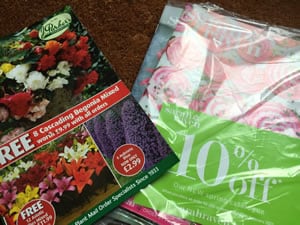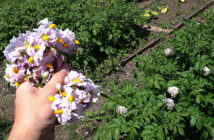 A new year invariably brings much excitement to gardeners and allotmenteers as they look longingly ahead to Spring and the growing season. Seed catalogues arrive on our doormats to bring some optimism to the cold gloomy days spent indoors yearning for sunshine on our faces and mud on our boots. A degree of impatience is always evident on Internet forums, especially among those new to grow-your-own, ‘Have I missed the potato season?’ and ‘Why have my seeds not germinated?’ being just two questions I’ve seen asked in the past week… of mid-January!
A new year invariably brings much excitement to gardeners and allotmenteers as they look longingly ahead to Spring and the growing season. Seed catalogues arrive on our doormats to bring some optimism to the cold gloomy days spent indoors yearning for sunshine on our faces and mud on our boots. A degree of impatience is always evident on Internet forums, especially among those new to grow-your-own, ‘Have I missed the potato season?’ and ‘Why have my seeds not germinated?’ being just two questions I’ve seen asked in the past week… of mid-January!
Seasoned growers will know that being too early to the party doesn’t make plants grow any more quickly, and can in fact result in weaker plants with lower yields (less daylight, unexpected frosts). They will also know that it makes good sense to plan your planting layout well in advance. This ensures that the location of crops can be well thought out, as well as providing a reference guide for next year; you’ll more easily remember where NOT to plant things again (assuming you’re following at least some kind of basic rotation plan to reduce pests, diseases and avoid mineral imbalance).
When it comes to planning my allotment I always turn to the GrowVeg.com Garden Planner app, it’s a superb online tool that makes allotment planning fun and uses up some of that gardening energy I have by giving me something practical to do indoors during Winter. I find the software easy to use to create my allotment layout and it isn’t finished when I’ve stopped designing, the app sends email alerts to remind me when to sow plants (even factoring in local weather station information).
Using the GrowVeg App is Easy:
- Measure your garden/allotment’s real life dimensions (in metres or sq ft).
- Use the GrowVeg app (in m2 or ft2) to map your allotment on screen.
- Insert paths and static objects like raised beds, sheds and compost areas.
- Drag and drop your chosen crop varieties into the beds and expand to fill the desired area.
- GrowVeg will estimate the number of plants you need and provide a planting guide based on local weather station information (frosts etc.)
- GrowVeg can send you email reminders so you know when to plant crops.
- Create additional views per month to factor in succession planting (harvesting, empty beds and new sowing).
Companion Planting (Intercropping)
In theory different plant species have different plant ‘friends’, friends that can be relied on for support, shade, beneficial nutrients or for warding off a pest with a fragrance they’re not keen on. Equally some plant species have conflicting species which they would rather not grow alongside. Gardeners have known about some of these plant relationships for thousands of years and used the information to their advantage to increase growing success, we call it ‘Companion Planting’ – scientists prefer to call it ‘Intercropping’.
When you look into it there actually haven’t been that many modern scientific studies of intercropping at work, I’ve read the results of one or two experiments but the majority of the companion planting tables online include aggregated individual experiences and guidance passed on from our ancestors. If you are going to factor in companion planting it requires you to think carefully about the location of your crops and the location of their neighbours. It may even require you to grow the odd herb that you hadn’t thought about but given the positive benefit to your primary crop you grow it all the same.
My Companion / Intercropping Recommendations
On my allotment I have a series of raised beds separated by paths so I don’t worry too much about ‘bad neighbour proximity’. However, as a rule I do try to spread some of my crop types about into various ‘mixed companion’ beds so as not to leave all of the plants on one ‘easy to walk and consume’ row for pests. I also try to use the corners of my raised beds to grow a repellent intercrop such as Mint, French Marigold or Garlic. I have listed below some of the known pests and their generally recognised repellent plant(s):
- Aphids (Roses) – Garlic
- Cucumber beetles – Radishes, Amaranthus
- Carrot root fly – Mint, French Marigolds (Tagetes patula)
- Onion fly – Mint
- Peach Borer – Garlic
- Whitefly (Tomatoes) – French Marigolds (Tagetes patula)
An additional idea is to plant sacrificial crops as a distraction from the real prize (your veg crops). I always have an abundance of Nasturtiums growing at the allotment as a sacrificial crop – aphids love them and this lures them away from my climbing beans (runners etc.). I also intercrop Nasturtiums with my winter squash and pumpkins because the flowers draw in bees – this increases pollination on pumpkins (female pumpkin flowers are only viable for half a day so they need all the help they can get!). Blue Hubbard winter squash (Cucurbita maxima) have been proven in scientific tests to draw cucumber beetles away from other squash and cucumbers – so worth growing away from your main squash bed and cucumbers.
As it happens the GrowVeg App now includes a companion planting feature which makes it much easier to place your crop in a companion-friendly location. Below is an additional video from the folks at GrowVeg about this new feature as well as a further summary of what Companion Planting is.





1 Comment
Pingback: Growing Your Own Food: Expanding A Hobby To Lifestyle - Blogging Mrs B